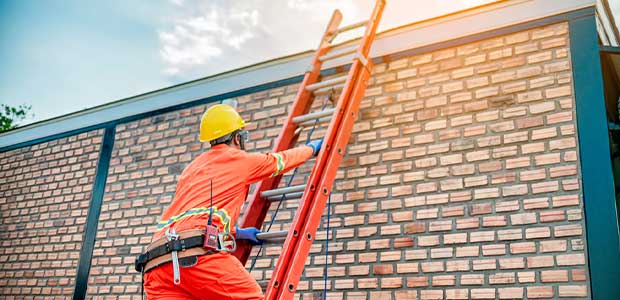
National Ladder Safety Month 2023: Safety Tips for Before and During Your Climb
Ladders are an incredibly useful tool, but it’s essential that workers know how to use them properly.
- By Alex Saurman
- Mar 24, 2023
Earlier this month, we addressed factors to consider when selecting the right ladder for the job. Now, we’ll cover how to safely use it.
Before the Climb
Before you start your journey up the ladder, there are a few steps you need to take. They might not take long, but they could mean the difference between working safely and ending up with an injury.
Perform an inspection. Examine the ladder to make sure everything works and no parts are broken. The American Ladder Institute (ALI) recommends checking “locks and spreader braces, steps and rungs, rails, connections and fasteners, safety shoes and ropes and pulleys.” If any of these are damaged, pull the ladder from use. It’s also a good idea to read any labels on the ladder.
Check the surroundings. Before you set the ladder up, ensure that the ground is level and stable enough to support the ladder and you. Check for nearby objects, like unlocked doors or windows, that could hit the ladder, causing it and you to fall. Another factor to consider, per ALI, is the weather. If conditions make it unsafe to use a ladder, wait until the weather is ideal.
Check-in with yourself. Do you feel physically well enough to climb? If you don’t, consider waiting until you feel better. Are your shoes clean? Make sure there’s nothing stuck to the bottom that could cause you to slip.
The Climb
You’ve got your ladder. You’ve done the necessary inspections. Now, it’s time to climb.
Face forward and move slowly. Don’t climb up the ladder backward or with one side of your body. You should be facing the ladder with every step you take. It’s also not a race to get to the top. Take your time and pay attention as you climb.
Follow the three-point-of-contact rule. As you climb, ensure that two hands and one foot or two feet and one arm are always on the ladder. You should also never overreach. Overreaching is one of the two leading causes of ladder incidents, per ALI.
Stay centered and parallel. Use the center of your stomach to ensure you stay centered on the ladder. It should always be between the side rails, according to ALI. When climbing, don’t learn or shift your weight either.
Don’t carry tools. If you have tools you need to use, don’t carry them up the ladder with you. Put them in a tool belt or use a hand line to get them to the top.
Knowing how to use ladders safely can save lives.
About the Author
Alex Saurman is a former Content Editor for Occupational Health & Safety,who has since joined OH&S’s client services team. She continues to work closely with OH&S’s editorial team and contributes to the magazine.